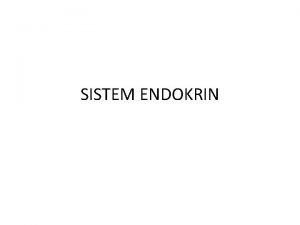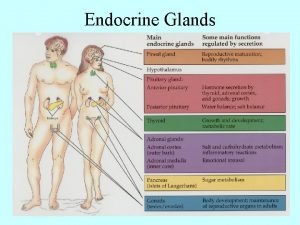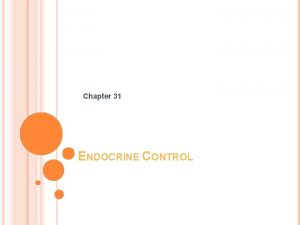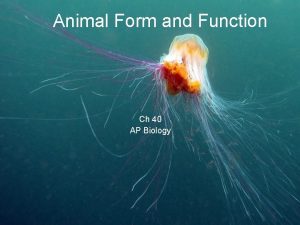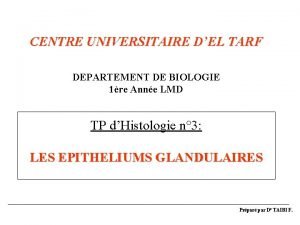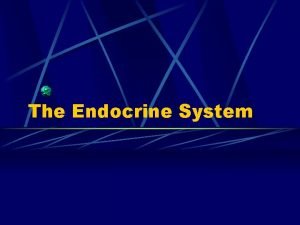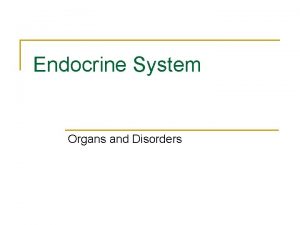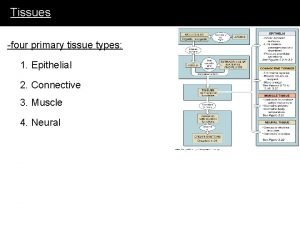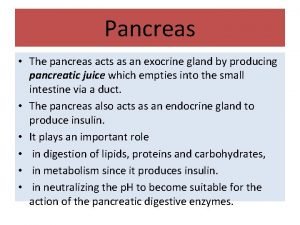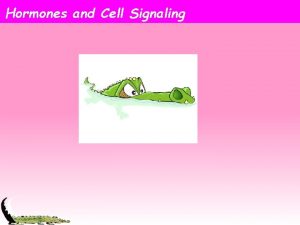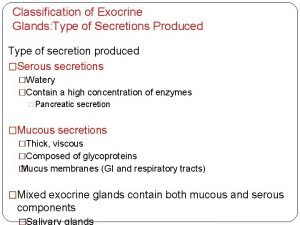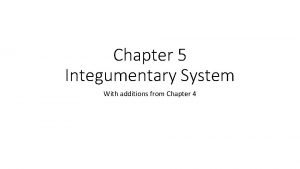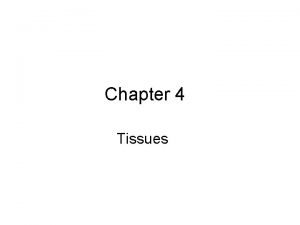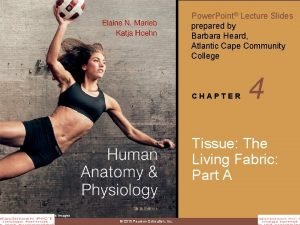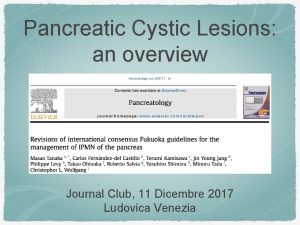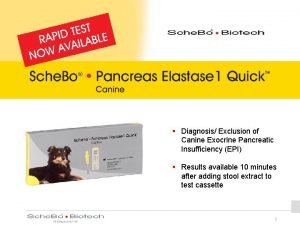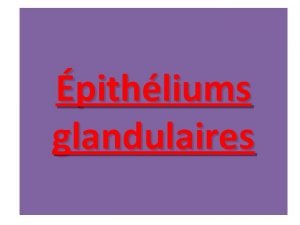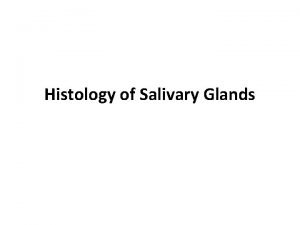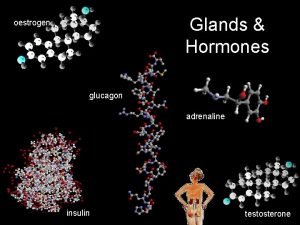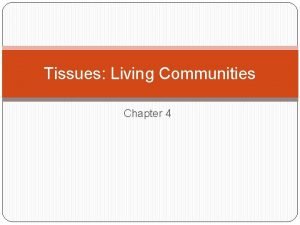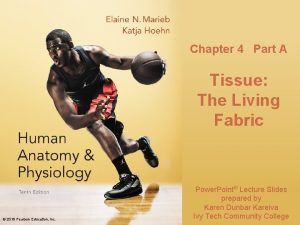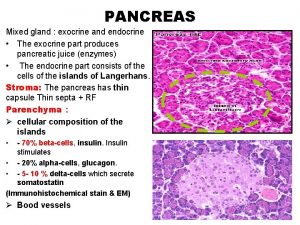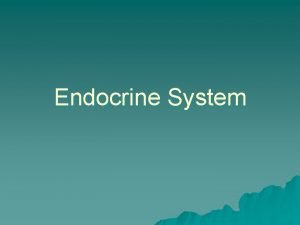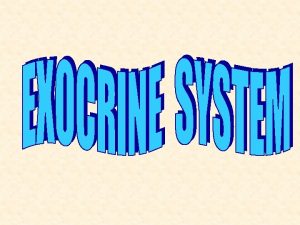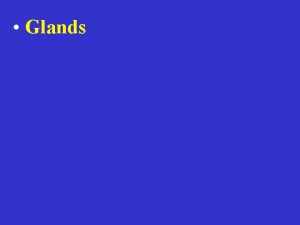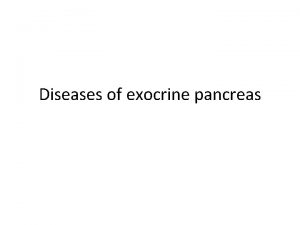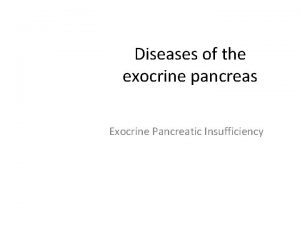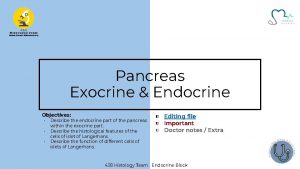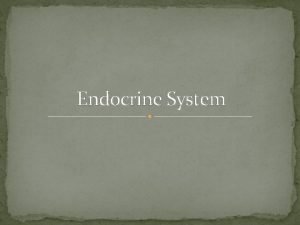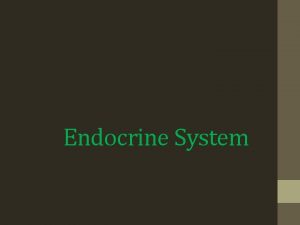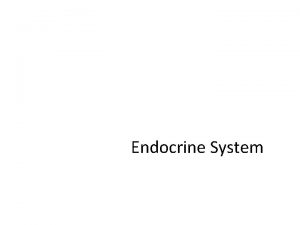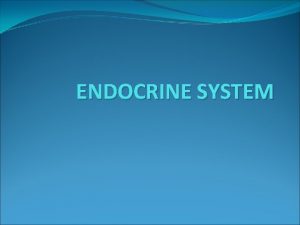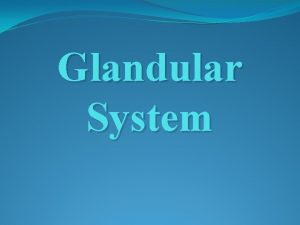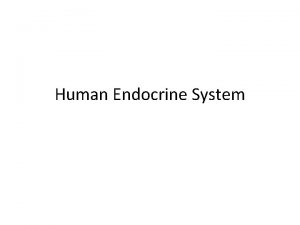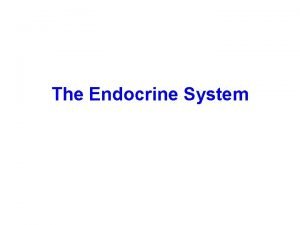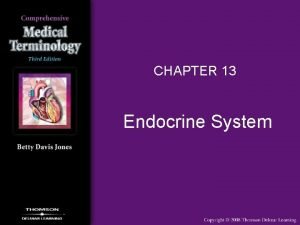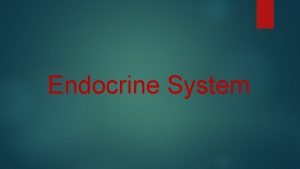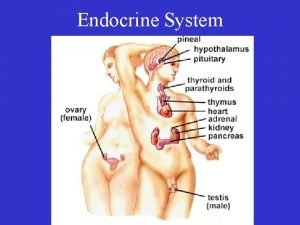The Endocrine System Endocrine System Endocrine vs Exocrine




















































- Slides: 52

The Endocrine System

Endocrine System Endocrine vs. Exocrine Organs are not physically connected Alters activities of target organs/cells Purpose: Growth/Development Reproduction Regulation Stress Reactions

Hormones are Activated By Hormonal Humoral Neural

Gland/Hormone Functions Some glands produce >1 hormone Some hormones produced by >1 gland Some organs have >1 function Some hormones have >1 function

Functions of Endocrine Glands Endocrine Functions only Production Secretion Contained within other organs which have other functions

Categories of Glands Central: Pituitary Hypothalamus Peripheral: Thyroid Adrenals Parathyroids Thymus Pineal Gonads Pancreas Others

Hypothalamus Found on floor of diencephalon Neural and endocrine functions Biofeedback mechanism for: Osmotic pressures Temperature regulations Metabolic functions

Pituitary Extends from Hypothalamus-behind sphenoid bone “Master Gland” of body Anterior- Portal network Posterior- Neural-contains axons of Hypothalamus neurons

Anterior Pituitary GH- Growth Hormone Prolactin TSH- Thyroid Stimulating Hormone ACTH- Adrenocorticotropic FSH- Follicle Stimulating Hormone LH- Luteinizing Hormone

Posterior Pituitary ADH- Anti-Diuretic Hormone Oxytocin

Pituitary Disorders Acromegaly- Hypersecretion of GH Dwarfism- Hyposecretion of GH

Thyroid Inferior to larynx 2 Lobes T 3 - Triiodothyronine T 4 - Thyroxine Calcitonin

Thyroid Disorders Hypothyroidism- Hyposecretion Hyperthyroidism- Hypersecretion l Graves Disease Goiters- iron deficiencies

Parathyroids 4 small glands posterior surface of thyroid Parathyroid hormone Responsible for osteoclast of bone Decreases blood phosphate levels (By way of kidneys) Enhances activation of Vitamin D

Parathyroid Disorders Hyperparathyroidism “Moan and groan, stones and bones”

Pineal Gland Forms part of diencephalon Melatonin Inhibits hypothalamus release of gonadotropins Melatonin-decreases in light/increase in dark (circadian rhythm)

Thymus Gland Posterior to sternum, around great vessels Thymosin Both lymphatic and endocrine Lymphatic- produces T-lymphocytes Endocrine- ‘programs’ T-cells

The Adrenals Located on superior end of each kidney Medulla- inner gland Cortex- outer gland

Adrenal Medulla Sympathetic preganglionic fibers synapse on cells in medulla Release of epinephrine/norepinephrine into general circulation

Adrenal Cortex Produce over 30 steroid hormones Three main cortical hormones Mineralocorticoids Glucocorticoids Sex hormones

Mineralocorticoids Regulate levels of electrolytes and water in extracellular fluid 95% are aldosterone Sodium reabsorption l Potassium excretion l

Glucocorticoids Influence carbohydrate metabolism Important in body’s response to stress 95% cortisol (hydrocortisone) stimulates gluconeogenesis secretion is regulated by ACTH

Sex Hormones Androgens (testosterone) Estrogens Both are secreted in greater numbers by gonads

Adrenal Disorders Cushing’s diseasecortisol over-production secondary to increased ACTH Addison’s Diseasecortisol/aldosterone deficiencies

Gonads Testes- males Testosterone Ovaries- females Estrogens Progesterone Both produce hormones/gametes

Pancreas Retroperitoneal-posterior to stomach Exocrine & Endocrine- islets of Langerhans Alpha Beta Delta

Alpha cells 20% of islets Hormone glucagon Stimulates breakdown of glycogen in liver- raises glucose levels in blood (glycogenolysis & glyconeogenesis)

Beta Cells 75% of islets Hormone- insulin Decreases glucose levels

Glucose Metabolism Organic components of food: Carbohydrates (instant-energy) Glucose Fats Fatty acids/glycerols Proteins Amino acids

Carbohydrate Metabolism Insulin is released by humoral, hormonal, neural means Increased glucose Parasympathetic stimulation Gastrointestinal hormones

Carbohydrate Metabolism 60% of carbohydrates are stored as glycogen in liver If muscles are not exercised after eating-stored as muscle glycogen

Glycolysis Glucose is broken down into pyruvate and lactate- releasing 2 ATPs (Anaerobic metabolism) Krebs Cycle

Fat Metabolism A third of any glucose passing through liver is converted to fatty acids Fatty acids are converted to triglycerides and stored in adipose tissue

Fat Metabolism Without insulin, fat is broken back down into triglycerides/cholesterol CAD Fatty acids are also broken down into ketone bodies

Protein Metabolism In absence of insulin- protein storage stops and breakdown begins (muscle) Amino acid breakdown for energy leads to increased urea in urine organ dysfunction

Pancreas Disorders Diabetes. Type 1 - Juvenile onset l Type 2 - Mature onset l Gestational diabetes l

Type 1 Diabetes Insulin dependant S/S: polyuria polydipsia polyphagia blurred vision weight loss

Type 2 Diabetes Generally non-insulin dependant Has ability to make small amounts of insulin Can develop into insulin dependant

Gestational Diabetes Develops during pregnancy Deficiencies in insulin leads to inability to metabolize carbohydrates Generally disappears after delivery

Insulin Agents Early- porcine, bovine Recent- genetic engineered human insulin Protein Rapid, intermediate and long-term Combination of long-term, rapid each day

Insulin Types Regular- Fast acting 0. 5 -1 hour onset 6 -8 hour duration NPH- Intermediate 1 -1. 5 hour onset 24 hour duration

Insulin Types Ultralente- Long acting 4 -6 hour onset 36 hour duration Oral agents: Diabinese (chlorpropamide) l Orinase (tolbutamide) l Micronase (glyburide) l Glucotrol l

Diabetic Emergencies Hypoglycemia Hyperglycemia Diabetic Ketoacidosis (DKA) Hyperosmolar Hyperglycemic Nonketotic Coma (HHNK)

Hypoglycemia Rapid on-set < 60 mg/dl Causes: too much insulin decreased intake salicylates excessive activity beta blockers emotional stress hypothermia chronic alcoholism sepsis

S/S of Hypoglycemia Altered LOCs- irritability, nervousness, confusion, combative Cool, clammy Weak, rapid pulse Snoring, salivation Normal BP

Diabetic Ketoacidosis Fat metabolism leads to ketoacids Acidosis leads to K+ in circulation & hyperkaluria K+ deficiency Osmotic diuresis dehydration, electrolyte imbalances

S/S of DKA Warm, dry skin Dry mucous membranes Tachycardia, thready pulse Postural hypotension Weight loss ‘Polys’

S/S of DKA Abdominal pain Anorexia, nausea/vomiting Acetone breath Kussmauls Decreased LOC

Hyperosmolar Hyperglycemic Nonketotic Coma Generally Type II diabetic Osmotic diuresis secondary to sugars Not acidotic as in DKA Factors: Geriatric Preexisting diseases Increased insulin requirements Medication use- thiazide, diuretics Parenteral/enteral feedings

S/S of HHNK Weakness Thirst Polyuria Weight Loss Extreme dehydration

Treatment of Diabetic Emergencies Hypoglycemia- ABCs IV- NS Monitor ECG Oral, IV Dextrose Poss. Glucagon IM Poss. Thiamine Monitor glucose!

Treatment of Diabetic Emergencies Hyperglycemia (DKA, HHNK)ABCs O 2 IV- NS Monitor ECG for abnormalities
 Exocrine vs endocrine
Exocrine vs endocrine Difference between endocrine and exocrine glands
Difference between endocrine and exocrine glands Endocrine exocrine
Endocrine exocrine Whats the difference between endocrine and exocrine glands
Whats the difference between endocrine and exocrine glands Endocrine exocrine
Endocrine exocrine Glande endocrine exocrine
Glande endocrine exocrine Endocrine vs exocrine
Endocrine vs exocrine Endocrine versus exocrine
Endocrine versus exocrine Tissue
Tissue Action of pancreatic juice
Action of pancreatic juice Endocrine and nervous system comparison
Endocrine and nervous system comparison Exocrine cell signaling
Exocrine cell signaling Classification of exocrine glands
Classification of exocrine glands Papillary layer
Papillary layer General structure of exocrine glands
General structure of exocrine glands Basal and apical surface
Basal and apical surface Ipmn
Ipmn Endocrine weight loss
Endocrine weight loss Canine exocrine pancreatic insufficiency
Canine exocrine pancreatic insufficiency Glandes tubuleuses droites
Glandes tubuleuses droites Liver histology
Liver histology Exocrine glands
Exocrine glands A multicellular exocrine gland consists of ______.
A multicellular exocrine gland consists of ______. The only example of unicellular exocrine glands are
The only example of unicellular exocrine glands are Endocrine system and reproductive system
Endocrine system and reproductive system Endocrine system and nervous system
Endocrine system and nervous system Lympathic
Lympathic General mechanism of hormone action
General mechanism of hormone action Endocrine system and nervous system
Endocrine system and nervous system Hình ảnh bộ gõ cơ thể búng tay
Hình ảnh bộ gõ cơ thể búng tay Slidetodoc
Slidetodoc Bổ thể
Bổ thể Tỉ lệ cơ thể trẻ em
Tỉ lệ cơ thể trẻ em Chó sói
Chó sói Thang điểm glasgow
Thang điểm glasgow Chúa yêu trần thế alleluia
Chúa yêu trần thế alleluia Các môn thể thao bắt đầu bằng tiếng nhảy
Các môn thể thao bắt đầu bằng tiếng nhảy Thế nào là hệ số cao nhất
Thế nào là hệ số cao nhất Các châu lục và đại dương trên thế giới
Các châu lục và đại dương trên thế giới Công thức tính thế năng
Công thức tính thế năng Trời xanh đây là của chúng ta thể thơ
Trời xanh đây là của chúng ta thể thơ Mật thư tọa độ 5x5
Mật thư tọa độ 5x5 Làm thế nào để 102-1=99
Làm thế nào để 102-1=99 Phản ứng thế ankan
Phản ứng thế ankan Các châu lục và đại dương trên thế giới
Các châu lục và đại dương trên thế giới Thơ thất ngôn tứ tuyệt đường luật
Thơ thất ngôn tứ tuyệt đường luật Quá trình desamine hóa có thể tạo ra
Quá trình desamine hóa có thể tạo ra Một số thể thơ truyền thống
Một số thể thơ truyền thống Cái miệng xinh xinh thế chỉ nói điều hay thôi
Cái miệng xinh xinh thế chỉ nói điều hay thôi Vẽ hình chiếu vuông góc của vật thể sau
Vẽ hình chiếu vuông góc của vật thể sau Nguyên nhân của sự mỏi cơ sinh 8
Nguyên nhân của sự mỏi cơ sinh 8 đặc điểm cơ thể của người tối cổ
đặc điểm cơ thể của người tối cổ Thứ tự các dấu thăng giáng ở hóa biểu
Thứ tự các dấu thăng giáng ở hóa biểu
